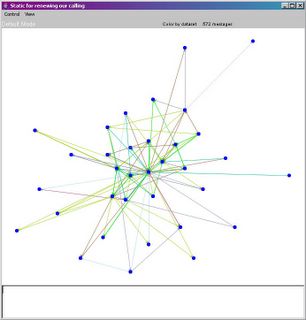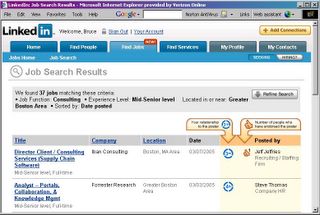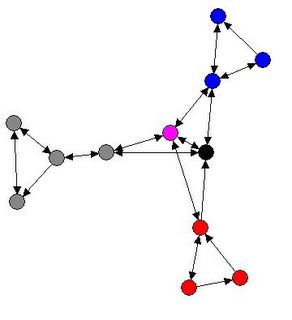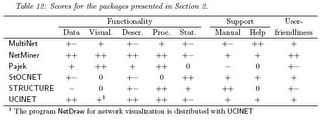Tuesday, March 29, 2005
Here comes Yahoo! 360
See also this collection of related news stories compiled by Ross Mayfield of Many 2 Many.
Saturday, March 26, 2005
Weekend Edition: No Man's Land
I used to race bikes in college and still follow the sport, especially every July for the Tour de France.
Here in America we all know Lance Armstrong, who has won a record six straight Tours and recently announced his intent to win a seventh. But few Americans appreciate the team dynamics and strategy that are the heart of what road racing is about. A rider may be strong enough to pull away from his competitors; but if he doesn't get support from his teammates, he won't get very far. Instead of winning the race with his show of power, he will merely end up in no man's land:
No man's land is a hopeless and lonely place doomed to be swallowed by the multitudes (or peloton as bike riders like to say).
Being in front in a bike race isn't always bad, of course. In fact, being in front at the end is called winning:
Here we see Alessandro Petacchi winning last week's Milan San Remo, the pinnacle of Italian cycling classics. Petacchi is alone in front at just the right moment---a moment only possible thanks to the strength and strategy of his Fasso Bartolo team.
Thursday, March 24, 2005
Coming to the Mass Bay OD Learning Group April 21
Social Network Analysis
A tool to help the OD practitioner
- Create a powerful picture of an organization,
- Convey the whole-system OD perspective to your client,
- Identify key roles hidden inside an organization,
- Understand better how an organization really works.
Wednesday, March 23, 2005
Seeing the whole system

Monday, March 21, 2005
Visualizing email history as social networks
I downloaded it this morning and in no time turned my Six Sigma Church email folder into this picture:

Each node is a person on the project, and each edge represents an email that I was at least cc'd on. If I got everyone else's email folders fed into TeCFlow, then the resulting picture would be of the entire system, not just my view.
Even more importantly, I'd like to get TeCFlow to recognize who the members of various mailing lists are. Right now, the graph represents each email list as an individual node, rather than showing who is really receiving those group emails.
For another well-studied perspective on visualizing email history as social networks, see Soylent, the PhD work of Danyel Fisher (formerly UC Irvine, now doing community technology at Microsoft). I heard Danyel give a great talk on Soylent at Sunbelt XXV, and only wish that Soylent supported Outlook.
Friday, March 18, 2005
Software for Social Network Analysis
By way of prepation, I've been delving more deeply into social network visualization software. I just got a beta copy of Krackplot 4, which is great for making dramatic animated morphing networks as shown here.
I've also been fiddling around in various ways with UCINET, Pajek, InFlow, and Netminer -- a few of the notable software packages out there for social network analysis.
For those of you curious to know more about software for SNA, here's a nicely done review by Mark Huisman and Marijtje A.J. van Duijn, "Software for Social Network Analysis." Over the course of 54 surprisingly readable pages, the authors review every bit of software listed on the INSNA catalogue. They conclude with an amazingly concise chart of rankings, which I have reproduced below:
Thursday, March 17, 2005
Shamrock Power and Social McNetworks
- Customized Response (collaborative innovation)
- Modular Response (collaboration between roles, rather than individuals)
- Routine Response (efficient execution of a well-understood procedure)
- Collaborative Innovation
- Collaborative Learning
- Collaborative Interest
CASE ZERO:
Zero is nothingness. The void. A number better left to mathematicians and zen monks.
CASE ONE:
One is unity. I am one. The universe is one. One is a great number with deep psychological implications, but one is not social enough to be our focus.
CASE TWO:
Two is you and me. A relationship. For the first time we have real communication, which we can also write and record in binary if we wish. Things are now very social, but lacking context. What are we going to talk about?
CASE THREE:
Three is you, me, and other. A one-child family, a love triangle, a community. You and I always have something to talk about (the other). Three is smallest group in which I can be outvoted. Three is where the most fundamental social network action takes place.
For a rather mind-blowing glimpse at how deeply sociologists have considered the number three, see "The Significance of Numbers for Social Life," which recounts the life and work of Georg Simmel.
By the way, I learned of Simmel through the work of James Moody, who presented this "Periodic Table of the Social Elements," in his plenary talk at Sunbelt XXV:

Just as chemists can understand the behavior of matter as interactions of elements from the periodic table, so can we understand a great deal about our social networks by viewing them as interconnected elemental triads. (See also this post and Moody's powerpoint presentation.)
Of course, social network analysts aren't the only people obsessed with the number three. Saint Patrick, for example, favored the traditional shamrock for its leafy reference to the Holy Trinity.

Wednesday, March 16, 2005
HBR: A Practical Guide to Social Networks
It's a very sensible article advocating a measured and strategic approach to collaboration networks. (In other words, more collaboration is not always a good thing.) Most helpfully, the authors boil down their extensive experience in organizational networks to three fundamental types:
- Customized Response (collaborative innovation)
- Modular Response (collaboration between roles, rather than individuals)
- Routine Response (efficient execution of a well-understood procedure)
There's a great chart summarizing these three basic types, so that managers can identify which type of network is appropriate to their situation and then act accordingly.
You can buy a download of the article here.
Here is HBR's executive summary:
"Saying that networks are important is stating the obvious. But harnessing the power of these seemingly invisible groups to achieve organizational goals is an elusive undertaking.
"Most efforts to promote collaboration are haphazard and built on the implicit philosophy that more connectivity is better. In truth, networks create relational demands that sap people's time and energy and can bog down entire organizations. It's crucial for executives to learn how to promote connectivity only where it benefits an organization or individual and to decrease unnecessary connections.
"In this article, the authors introduce three types of social networks, each of which delivers unique value. The customized response network excels at framing the ambiguous problems involved in innovation. Strategy consulting firms and new-product development groups rely on this format. By contrast, surgical teams and law firms rely mostly on the modular response network, which works best when components of the problem are known but the sequence of those components in the solution is unknown. And the routine response network is best suited for organizations like call centers, where the problems and solutions are fairly predictable but collaboration is still needed.
"Executives shouldn't simply hope that collaboration will spontaneously occur in the right places at the right times in their organizations. They need to develop a strategic, nuanced view of collaboration, and they must take steps to ensure that their companies support the types of social networks that best fit their goals. Drawing on examples from Novartis, the FAA, and Sallie Mae, the authors offer managers the tools they need to determine which network delivers the best results for their organizations and which strategic investments nurture the right degree of connectivity."
Friday, March 11, 2005
The Dynamics of Information at the Human Networks Colloquium
This looks very interesting. I wish I could go! For more information contact Professor David Lazer at Harvard University.
TUESDAY March 15, 1-2pm
Bartos Theater (Note change from usual day!)
The Dynamics of Information
Bernardo A. Huberman, Director, HP Labs
The dynamics of information within organizations is relevant to issues of productivity, innovation and the sorting out of useful ideas from the general chatter of a community. How information spreads and is aggregated determines the speed with which individuals and organizations can act and plan their future activities.
This talk will describe new mechanisms for automatically identifying communities of practice within organizations and for elucidating the spread of information spreads within those communities. In addition, a new method for forecasting uncertain events using small groups of people will be presented, along with empirical results that show its efficacy at making predictions in the laboratory and in the real world.
Bio: Bernardo Huberman is a Senior HP Fellow and director of Information Dynamics research at HP Labs. His current research is focused on designing novel mechanisms for accessing and aggregating disperse information, as well as enhancing privacy and trust in electronic transactions and negotiations. The main focus is the harvesting of community knowledge within organizations.
Previously, Huberman's research concentrated on the World Wide Web, with an emphasis on the dynamics of its growth and use. This work helped uncover the nature of electronic markets, the detailed structure of the web and the laws governing the way people surf for information. One of the originators of the field of ecology of computation, Huberman recently published the book, "The Laws of the Web: Patterns in the Ecology of Information," with MIT Press.
Huberman is a Fellow of the American Physical Society, a Fellow of the American Association for the Advancement of Science (AAAD), former trustee of the
Wednesday, March 09, 2005
The Perversity of LinkedIn

This is a pretty cool setup. Next to each job that matches my search criteria, LinkedIn shows me who posted the job and how many degrees I am removed from that person. If I investigate a particular job title, with one more click I can see all the hiring managers in my network at that company.
As cool as that is, I was even more excited to see a position on the board that actually interested me. (I am actively looking for new professional opportunities.) So with more than academic interest, I put LinkedIn through its paces, with an eye to reporting my findings here.
What did I find? Linked in is helpful, but mostly when I don't really need its help after all. My first attempt to connect via LinkedIn met with a polite rejection. Then with a little more detective work I found a better connection, not a hiring manager but only two degrees away. As I entered my LinkedIn connection request, I got the feeling I was making things too complicated, and sure enough my friend chose to introduce me to my target via regular email rather than through LinkedIn.
Rather than get frustrated at my inability to exploit LinkedIn to the fullest, I gave this situation some thought and realized it all makes perfect sense. To illustrate what I mean, I will borrow an example from a very nice SNA primer written by James Millar (formerly of Bonfire Consulting, now of Tapestry Networks). Consider the classic networking scenario. Alice wants an introduction to Bruce, but she doesn't know Bruce. Then one day Alice discovers that her friend Cindy does know Bruce:
Seeing how introducing Alice to Bruce will make both her friends happy, Cindy obliges. This is how networking has worked for millenia, with or without LinkedIn.
Now consider taking this scenario one step further. Suppose Alice again wants an introduction to Bruce, but this time Alice's friend Cindy doesn't know Bruce. Instead, Cindy knows David, who knows Bruce:
In this scenario, neither Cindy nor David can fully share the joy of introducing Alice and Bruce, and so the networking will probably stall (if it even gets started).
Considering these two scenarios, you can begin to see the perversity of LinkedIn. In the first scenario, Alice may need LinkedIn to discover her connection to Bruce, but after that she has no need of LinkedIn's elaborate request-forwarding service. She can just ask Cindy to introduce her directly.
In the second scenario, however, Alice may not even know of David's existence, and Cindy may be unaware that David knows Bruce. How will Alice ever know to ask Cindy to approach David? Only with a power-assisted request from LinkedIn. So LinkedIn really can help -- in precisely the scenario when the intermediaries have almost nothing to gain by cooperating.
Tuesday, March 08, 2005
Discussion with Valdis Krebs: What is a "social" network?
For those of you not familiar with him, Valdis is a notable entrepreneur of social network analysis with an impressive record of consulting and a nice library of white papers; he has also created one of the more convenient network visualization and analysis tools, InFlow. I have long included his website on my resource list and recommend it to you. I also find that his website has attracted a good audience of Furlers, and so if you read "who is Furling organizational SNA" in my resource list, you are actually seeing who has Furled Valdis Krebs.
Anyway, here are the mystery quotes, once again:
- "Organizational SNA is not a viable economic model."
- "Network analysis is huge, but not how you'd expect. It isn't organizational. It's at the business strategy level."
- "I'm not into social networks anymore. Now it's value networks."
- "Our foundation promotes the production network approach [as opposed to social networks]."
I took at look at Valdis' survey and here are the questions:
With whom do you
Q1. exchange information, documents, schedules, and other resources to get your job done?
Q2. discuss what is going on in the company, and who is doing what?
Q3. seek inputs and opinions before making a key decision?
Q4. discuss new ideas and innovations in financial products and services?
Q5. discuss customer needs, requests, and feedback?
These questions are followed by a section inquiring about interactions with other departments, headquarters, customers, vendors, and databases. It's a nicely done survey.
As I mentioned in my reply to Valdis, I would have no problem labeling all the above interactions as "social" (though perhaps not "purely social"). Even in the case of database use, if you twisted my arm enough I would include that in a social network. (Some of my best friends have been databases, after all.)
All this gets me wondering what we are getting at with the word "social," so I looked it up. Definition one is "involving allies or confederates," which I translate to "involving relationships of people." In this context I feel comfortable labeling any network involving people (even with a database or two thrown in) as a "social network," and I applaud those who seek to unify our understanding of diverse networks under the "social network" umbrella.
Definition two of "social" is "marked by pleasant companionship with friends." This definition actually feels more natural to me than #1, and provides the context in which we must distinguish social networks from task, strategy, career, knowledge and innovation networks. And that is clearly a distinction worth making -- these types of networks not only involve different flavors of relationships, but they also behave differently as networks. For a glimpse of this, see here.
Saturday, March 05, 2005
The Internet Has Officially Arrived -- The New Yorker is Here!
Yes, The New Yorker website, formerly but a digital shadow, now includes actual articles. Someone please tell Al Gore that his invention has officially arrived.
Friday, March 04, 2005
Value Chains and Production Networks
"Organizational SNA is not a viable economic model."
"Network analysis is huge, but not how you'd expect. It isn't organizational. It's at the business strategy level."
"I'm not into social networks anymore. Now it's value networks."
"Our foundation promotes the production network approach [as opposed to social networks]."
In pondering these statements, I did a little research and ran into one of my personal pet peeves, the chaotic maelstrom where business and academic jargon collide. For anyone else intrigued by the above statements and seeking some solid ground on which to discuss them, I recommend the 11-page pdf "How Do We Define Value Chains and Production Networks" by Timothy J. Sturgeon of the Industrial Performance Center at MIT.
For additional perspective, see also this chain of posts.
Thursday, March 03, 2005
Knocking on the Doorway to Compassion
The "easy" part of that is information distribution. This week I created a new special-purpose blog to provide everyone easy access to the report. I expect this to be a disposable website and not much of a true blog, but if it grows into a true community instrument (see also this), I'll be sure to report that here. In any case, I'm very happy with how it all turned out, but Blogger really did try my patience as it insisted on republishing a lot more often than I really needed to during the creative process. I also strained the WYSIWYG editor beyond its limits a few times.
Soon comes the much harder part -- constructive dialogue! The survey has drawn attention to some sensitive areas; discussion without defensiveness will be tricky. Thankfully, the church leadership is ready for the challenge. In a moving preface to the survey report, the board of directors said,
"Seventy years ago Kurt Hahn, a progressive German Educator and founder of Outward Bound, insisted that one’s weakness is one’s greatest strength. He believed a weakness presents an opportunity to try new things, overcome fears, and test perseverance in a way that our natural talents cannot. Above all, weaknesses are a doorway to compassion. Let us clearly define our challenges and engage them as opportunities."








